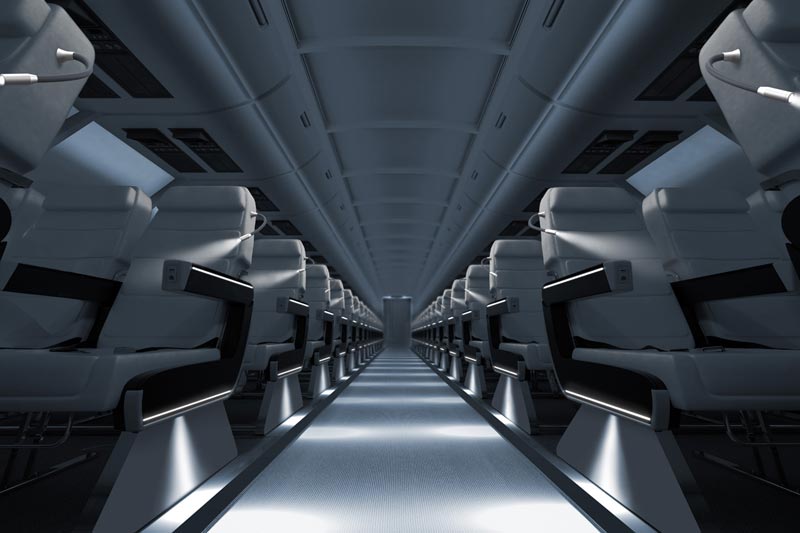
Flexible Illumination Solutions Redefine Aircraft Seat Design

Design, comfort, and functionality of airplane seats are given top priority. Lighting plays a particularly important role because it performs both functional and emotional tasks. SCHOTT offers high-quality cabin and seat illumination. Image: SCHOTT.
The inside cabin of a passenger aircraft contains a number of components that play an important role in passenger comfort, and in turn, brand loyalty. For example, seats are considered to be a key element in differentiating airline brands, and for that reason, the design, comfort, and functionality of the seats are given top priority.
Seat lighting also plays a particularly important role because it performs both functional and emotional tasks. The lighting expert SCHOTT offers a wide variety of different lighting concepts, based on both fiber optic and LED solutions, for airplanes, and will present these products at the Aircraft Interiors Expo (Booth 6B31) in Hamburg, Germany from April 14 to 16, 2015.
“Our customers place great importance on maximum freedom in aircraft seating design,” explains Yvonne Winter, Product Manager for Seat Lighting at SCHOTT Lighting and Imaging. “For example, a transition toward increasingly lighter and thinner seat shells is occurring in both economy and business class. At the same time, more lighting elements are being integrated throughout the seat, including pure reading lights, functional lighting for illuminating compartments, ambient lighting in seat foot wells, and side lighting of the table surface.”
Additionally, airlines and seat manufacturers want development times and costs to be as low as possible, and are interested in taking as little risk as possible when it comes to product tests. “With our lighting concepts, we enable airlines to develop their own individual seats and make use of lighting components that have already been officially approved,” notes Winter. “This means they can be creative and yet save time and money.”
SCHOTT’s solutions combine a firmly anchored, approved LED light source with fiber optic light guides that transport the light from the light source to all desired locations. The light source is anchored beneath the seat and is therefore invisible to the passenger’s eye. For its future solutions, SCHOTT will rely on RGBW light sources with a high degree of color stability for all of the protruding light guides.
“The combination of a light source and multiple light outlets ensures the same color transmission for each outlet, and therefore provides homogeneous illumination of the entire seat,” explains Winter. The various light guides that are connected to the light source are extremely thin and flexible. In fact, they are less than 5 mm thick and have a bending radius of around 15 mm. This allows them to be easily inserted into areas of the seat shell that are difficult to access. Furthermore, the fiber optic light guides are passive and do not contain any power supply lines. This means they do not generate electromagnetic interference (EMI) or undesirable heat.
Because the LED light sources and light guides have already been tested, only the customer-specific spot designs must be re-tested when approving the seat. SCHOTT is already successfully supplying its fiber optic lighting products to select seat manufacturers and airlines. For example, the SCHOTT® HelioLine Mood Light is already being used successfully by several airlines. The SCHOTT® HelioFlex Mood Light has also been integrated into passenger seats, and is now being used to illuminate aisles. It is extremely durable thanks to its metal and glass structure and even stands up to the unavoidable suitcase impacts.
“The design possibilities are abundant with SCHOTT’s lighting solutions, which can be tailored to match specific customer needs,” adds Winter. “There are no limits to creativity, yet at the same time, elements can be replaced on an individual basis. This is what is so attractive about our modular approach.”
For more information: http://www.schott.com/aviation/english/productsapplications/interior/seatillumination.html
SCHOTT is a leading international technology group in the areas of specialty glass and glass-ceramics. The company has more than 130 years of outstanding development, materials and technology expertise and offers a broad portfolio of high-quality products. SCHOTT is an innovative enabler for many industries, including the home appliance, pharmaceutical, electronics, optics, automotive and aviation industries. SCHOTT strives to play an important part of everyone’s life and is committed to innovation and sustainable success. The group maintains a global presence with production sites and sales offices in 35 countries. With its workforce of approximately 15,400 employees, sales of 1.87 billion euros were generated in fiscal year 2013/2014. The parent company, SCHOTT AG, has its headquarters in Mainz (Germany) and is solely owned by the Carl Zeiss Foundation. As a foundation company, SCHOTT assumes special responsibility for its employees, society and the environment. www.schott.com
Press contact
SCHOTT AG
Dr. Haike Frank
Public Relations Manager
Hattenbergstraße 10
55122 Mainz
Phone: +49 6131/66-4088
E-mail
http://www.schott.com
Further information
SCHOTT AG
Salvatore Ruggiero
Vice President Marketing and Communication
Hattenbergstraße 10
55122 Mainz
Phone: +49 6131/66-4140
E-mail
http://www.schott.com









![[Figure 1] Schematic of next-generation CNT-PANI composite fiber supercapacitor and comparison graph with recent results](https://www.innovations-report.com/wp-content/uploads/2025/05/KIST_leads_next-generation_energy_storage_technolo_1746783279-e1746784635527-362x245.jpg)


